Meal plan templates look to be a good idea for arranging your meal plans at home. It is a useful thing at home to serve more than one person, especially a big family. The meal plan template is only a person’s way to plan what you have to cook along the day and a constructive way in which you don’t need to leave your family. It is beneficial to assist you in preparing meal ingredients shopping. Of course, it is a versatile tool.
What Is a Meal Plan Template?
A meal plan template is a practical tool that helps you organize your meals ahead of time, aiding you in maintaining a healthier diet, saving time on meal preparation, and reducing food waste. It provides a structured format where you can note what you plan to eat for breakfast, lunch, dinner, and any snacks for a certain period, typically a week or a month.
Meal plan templates come in various forms, from simple handwritten charts to detailed digital spreadsheets or printable documents. These templates may include sections for each day of the week, specific meal times, ingredients required, and even space for nutritional information. Some advanced templates incorporate recipe links, grocery lists, or track macros and caloric intake for those focused on specific diet goals.
A meal plan template serves as a roadmap for your diet. It enables you to outline what you will eat and when keeping you on track with your dietary goals, be it losing weight, gaining muscle, adhering to a specific diet such as vegan or gluten-free, or simply promoting a balanced, healthy eating habit. It also takes the guesswork out of meal times, eliminating the last-minute scramble to prepare food or resort to unhealthy takeout options.
Types of Meal Plan Templates
Meal plan templates come in various formats, each catering to different needs and preferences. Here are some of the most common types:
- Weekly Meal Plan Templates: These templates provide a structured format for scheduling meals seven days in advance. They often include sections for breakfast, lunch, dinner, and snacks. This type is ideal for families and someone who prefer to do their grocery shopping once a week.
- Monthly Meal Plan Templates: These offer a broader view, allowing you to schedule meals for one month. Such a template is good for people who like to batch-cook or freeze meals in advance. It is also great for tracking seasonal food changes.
- Calorie Counting Templates: These are designed for individuals to track their caloric intake. Apart from meal planning, they include sections to list calorie content and, sometimes, other nutritional information. These templates are great tools for weight loss or managing specific dietary needs.
- Budget Meal Plan Templates: Budget templates assist you in planning meals while maintaining a way of your spending. They often include a section where you can write down prices or calculate the total cost of each meal.
- Diet-Specific Templates: These templates are designed around specific diets such as vegan, paleo, ketogenic, gluten-free, and more. They include meal options and snack ideas that adhere to the dietary rules of each particular diet.
- Family Meal Plan Templates: These are larger and more comprehensive, as they account for multiple individuals’ preferences. They are ideal for families and often include space for meal ideas, grocery lists, and even prep timelines.
- Fitness Meal Plan Templates: These are tailored towards athletes or individuals working towards specific fitness goals. They typically include sections to note down protein, carb, and fat content, aligning with the need to monitor macronutrient intake.
The right template relies on your requirements and the goals you want to achieve with your meal planning.
How to Use a Meal Plan Template
Follow these step-by-step instructions to create the most of your template:
- Select the Right Template: Choose a template that suits your preferences and requirements. Look for templates that provide enough space to record your daily meals, and consider additional sections for snacks or notes, if desired.
- Determine Your Planning Period: Decide how far you want to prepare your meals in the passage. Whether you prefer a weekly or monthly plan, consider your grocery shopping routine and the desired variety of meals.
- Outline Your Meals: Begin filling in your template with breakfast, lunch, dinner, and snack options. Consider your dietary goals, nutritional requirements, and specific dietary restrictions or preferences. Aim for a well-balanced combination of nutrients and flavors in your meal selections.
- Consider Practicality and Preparation Time: Consider your schedule and available meal preparation time. If weekdays are busy, plan for quick and easy meals. On days when you have more time, incorporate recipes that require longer preparation. Additionally, consider incorporating batch cooking or meal prepping to save time during the week.
- Create a Comprehensive Grocery List: Review and compile a comprehensive grocery list. Contain all the elements you will require for your intended meals. Organize the list by food categories or sections of the grocery store to streamline your shopping experience.
- Shop and Prep: With your grocery list, head to the store and purchase the necessary items. Once you return home, consider prepping certain ingredients or meals in advance. It could apply cleaning and dicing vegetables, cooking grains, or marinating proteins. Prepping will keep you time during the week and create sticking to your meal plan easier.
- Follow the Plan: Commit to following your meal plan as closely as possible. However, remain flexible and adaptable in case unexpected situations arise or adjustments need to be made. Remember, the meal plan is a guide to assist you in staying on track with your dietary goals, but it is okay to make modifications when necessary.
You can streamline your meal preparation process, save periods and cash, and confirm that you create healthy and balanced choices. Feel free to test with other templates and approaches until you find the best system.
Using Meal Plan Templates to Prepare a Delicious Meal
When you know what you will cook along the day, surely you have known what you bought every day. The arguments even don’t make you have the abilities to save your money. A clear meal plan template will make your life organized and the surrounding people feel happy. Meal plan templates are a wonderful meal plan template to serve delicious meal and foods on the dining table. You can eat with your family and beloved people happily.
When you watch advertisements on television or banner, it seems to persuade you to purchase it. With the help of the meal plan template free, you can decrease a consumptive shopping for food ingredients. For example, an advertisement promotes a new cereal product on television. You will get interested in immediately. However, with this meal plan templates, you can manage your consumptive interest because you have an ordered meal plan. Shopping meal ingredients without the list will make a huge problem. You can spend much more money because certainly, you are going to get teased on buying useless ingredients and things. Thus, the role of meal plan template is much needed.
Meal Plan Template Printable Offers Healthy Food Package
A food package certainly must have many benefits. The nutrition is an important part of the foods and meals. That is why a meal plan template printable becomes an alternative way to offer healthy food package. When you cook it at home and prepare the bought list of food ingredients, it tends to be easy and saving time. You can take foods containing balance nutrition and vitamins. Those can be gained from vegetables and fresh fruits.
If you select to make your meal plan templates free you are planning to cook at home. It is an important time that can be spent with family. You can serve a healthy meal and foods for dinner and breakfast. You are able to plan and manage the nutritional level of the cooked meal.
Creating Your Meal Plan Template
It can be exciting as it lets you personalize your meal planning according to your dietary needs and lifestyle. Here is how you can go about it:
- Identify Your Needs: The first step is identifying what you want from your meal plan. It could be weight loss, adhering to a specific diet, budgeting, or feeding a large family. Knowing what you want will guide the structure of your template.
- Choose Your Timeframe: Decide whether you want to plan daily, weekly, or monthly meals. Each option has its advantages. For instance, a weekly plan gives you a good balance between variety and preparation time, while a monthly plan is excellent for long-term budgeting and shopping.
- Outline Your Template: Draft a layout of your template. Include sections for each meal – breakfast, lunch, dinner, and consider including slots for snacks if necessary. Depending on your needs, you should also have a section for a grocery list, nutrition tracking, or cost calculation.
- Choose Your Platform: Decide whether you want your template to be digital or physical. Digital templates can be created using Excel, Google Sheets, or meal-planning apps. They are easy to edit and can be accessed from anywhere. On the other hand, physical templates can be written out or printed and put up in your kitchen for easy reference.
- Fill in Your Template: Start by filling in your favorite meals. Research recipes that align with your goals if you follow a specific diet or budget. Ensure to include a variety of foods to get a range of nutrients and keep your meals exciting.
- Test and Adjust: Use your template for a few weeks and then review. Adjust it as necessary — maybe you need more variety or specific days for leftovers. Your template should evolve with your needs.
Remember, the goal of your meal plan template is to make your life easier. It should reduce the stress of last-minute meal decisions and help you achieve your dietary goals more efficiently.
Customizing your meal plan templates
Customizing your meal plan templates allows you to personalize it according to your needs, preferences, and goals. Here are some effective ways to customize your meal plan templates:
- Meal Categories: Tailor the meal categories in your template to align with your eating habits. You can include sections for breakfast, lunch, dinner, snacks, or even specific meals like pre-workout or post-workout options.
- Portion Sizes: Add a section to your template to track portion sizes or serving measurements. This customization is helpful if you monitor your calorie intake or follow a specific dietary plan requiring portion control.
- Meal Variety: Customize your template to incorporate various meals and recipes. Include your favorite dishes, family recipes, or new recipes you want to try. It ensures that your meal plan is diverse, avoiding monotony and keeping your meals exciting and enjoyable.
- Special Dietary Needs: If you have specific dietary restrictions or nutritional requirements, adapt your template to accommodate them. For example, if you follow a vegetarian, vegan, gluten-free, or dairy-free diet, customize your meal options to suit your preferences.
- Grocery List: Enhance your template by including a dedicated section for a grocery list. This feature lets you stay organized and provides all the elements for your planned meals. Customize established on your chosen store layout or food categories to simplify your shopping experience.
- Notes or Reminders: Add a section for notes or reminders in your template. This space allows you to jot down cooking instructions, meal prep tips, ingredient substitutions, or any specific reminders related to your meal planning process.
- Color Coding or Themes: Create your template visually attractive and engaging by incorporating color coding or themes. Assign different colors to each meal category or introduce a theme that resonates with your style and preferences. This customization adds a touch of creativity and makes your template more enjoyable.
Customizing authorizes you to make a personalized tool that suits your lifestyle, dietary needs, and culinary preferences. It enhances your meal planning experience, making it more effective and enjoyable as you work towards reaching your health and health goals.
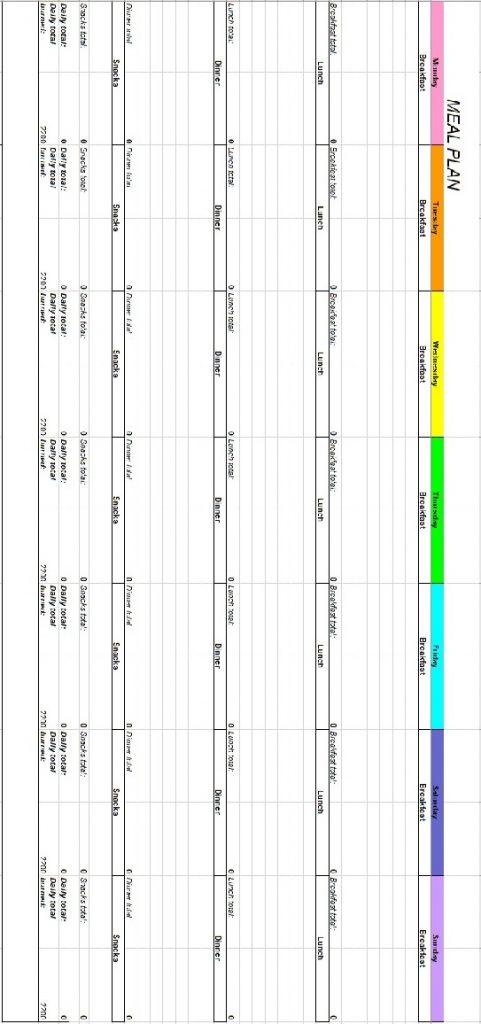
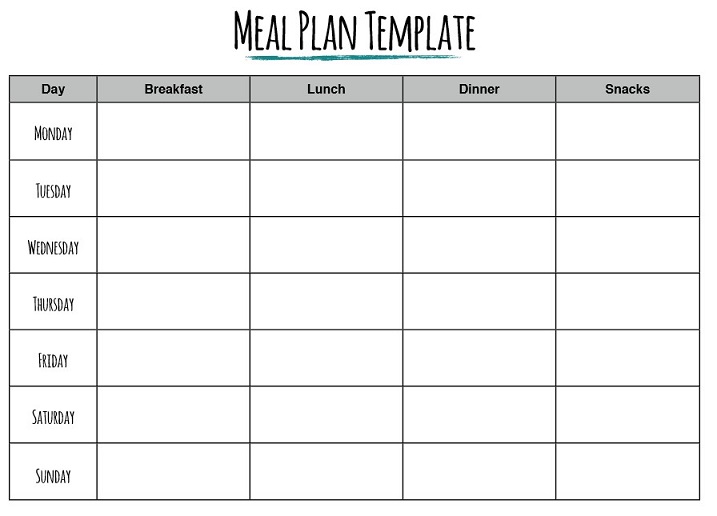
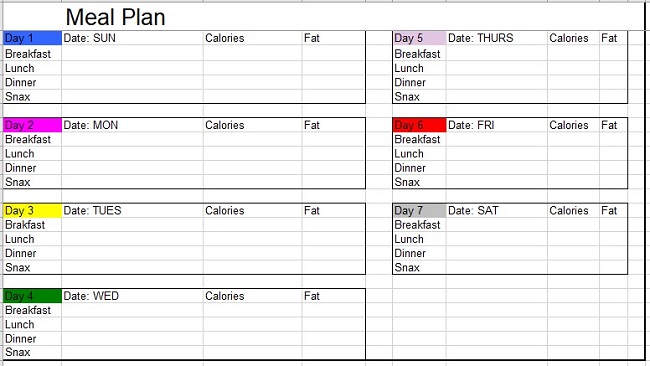
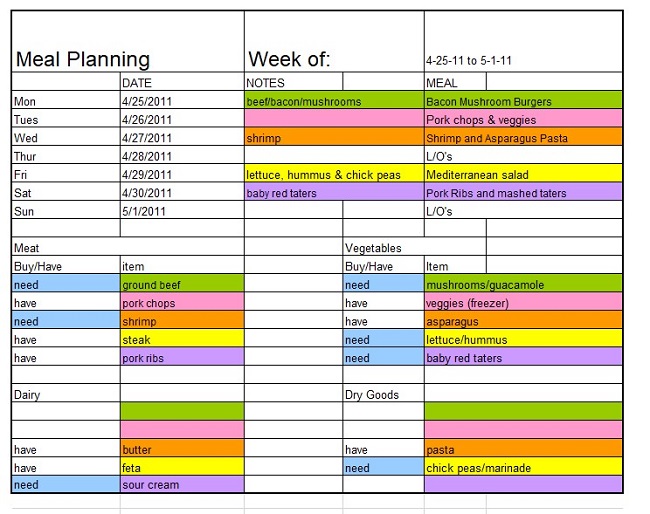
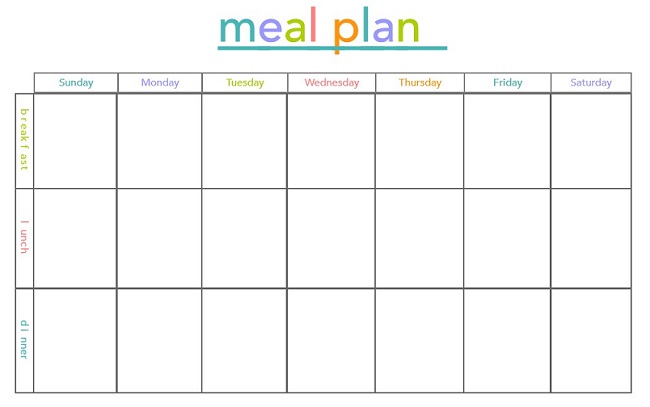
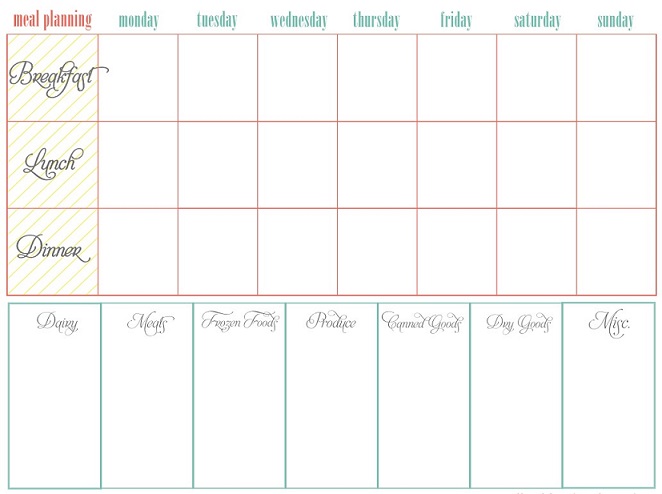
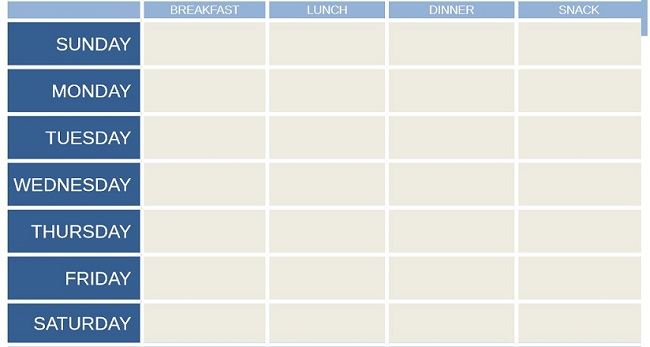
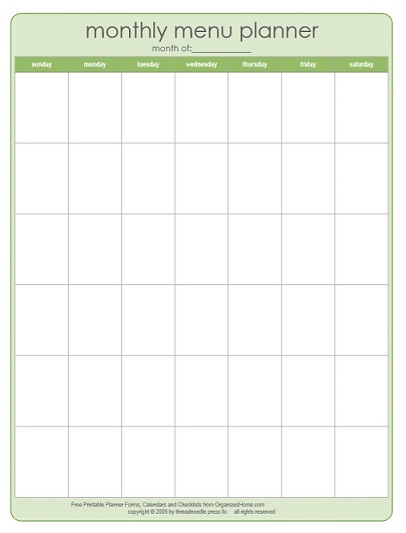
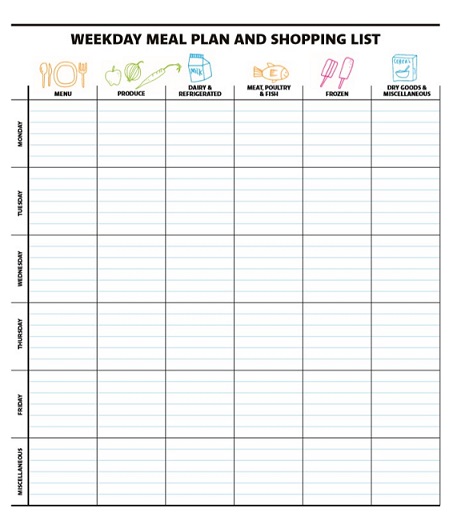
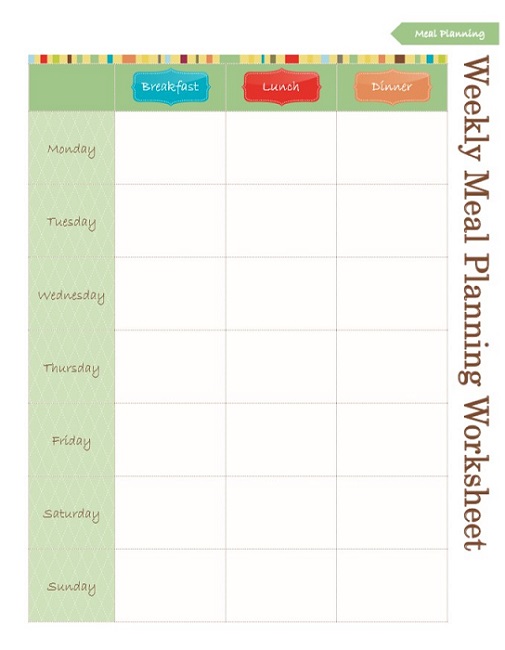
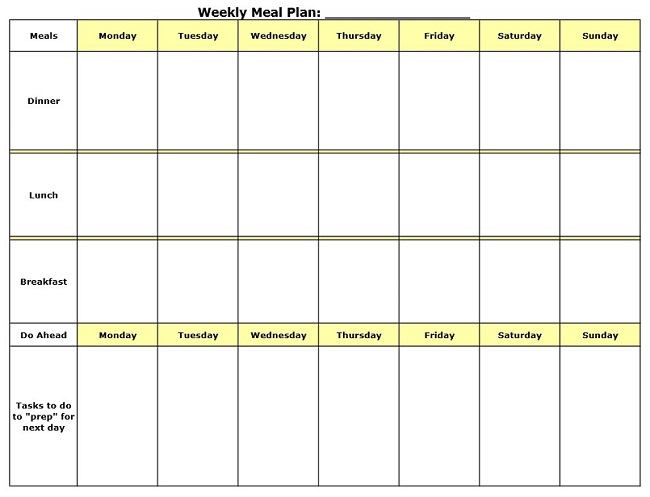
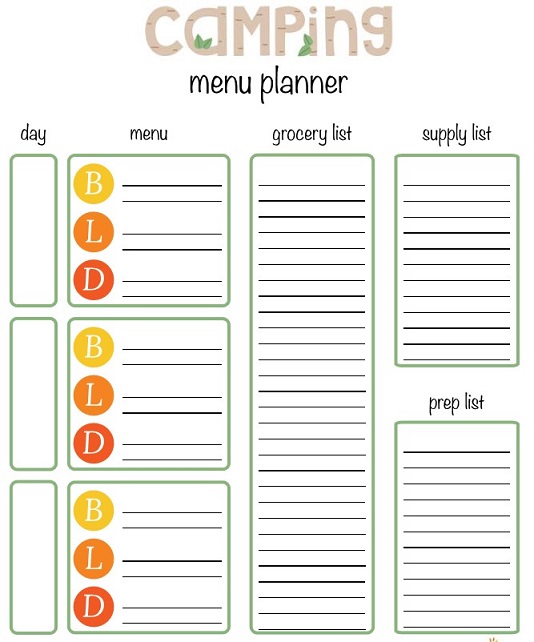
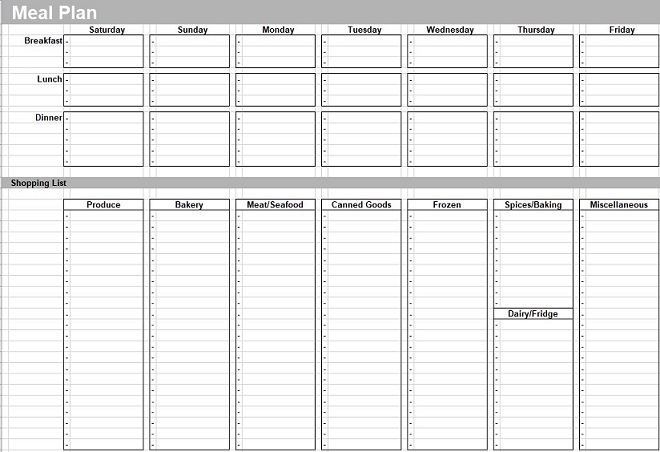
Practical Tips for Successful Meal Planning
Practical Tips for Successful Meal Planning:
- Begin with Beloved Dishes: Kickstart your meal planning process by incorporating your family’s cherished meals. Consider their likes, dislikes, dietary limitations, and specific nutritional requirements. Including familiar and enjoyable meals will ensure everyone looks forward to the meals and adheres to the plan.
- Incorporate Themed Evenings: Introduce themed evenings in your meal plan to inject diversity and make the process enjoyable. For instance, you could organize a “Mexican Night” with tacos, burritos, and enchiladas or a “Meatless Monday” with vegetarian dishes. Themed nights can simplify decision-making and introduce your family to new tastes and cuisines.
- Implement Batch Cooking: Allocate a particular day of the week for batch cooking. Cook more staple ingredients like grains, proteins, and sauces that can be used in multiple meals throughout the week. This strategy saves time and facilitates easy meal assembly during hectic weekdays.
- Opt for Freezer-Friendly Dishes: Cook meals that can be frozen and stored for extended periods. This approach is especially beneficial for busy days when you need extra time for cooking. Casseroles, soups, and stews are excellent choices that can be portioned and frozen for later use.
- Account for Leftovers: Do not forget to include leftovers in your meal plan. Cooking in larger quantities can yield ready-made meals for the next day, saving time and effort. Ensure to store leftovers properly to maintain their freshness and quality.
- Shop with a Prepared List: Always carry a well-prepared shopping list based on your meal plan. This practice helps you stay focused and prevents unnecessary purchases. Before shopping, check your pantry and refrigerator to ensure you have all the essential ingredients, and only buy what you need for your planned meals.
- Maintain Organization: Keep your meal plan and recipes organized in a central place, like a binder or a digital folder. This organization makes it easy to refer to and update your meal plan as required. Use meal planning apps or online tools to simplify the process and easily access your plan.
- Be Adaptable: Remember, your meal plan is a guide, not a strict timetable. Be adaptable and ready to adjust to unexpected changes or spontaneous events. If a planned meal does not work out, have alternative options or be ready to switch ingredients or meals without stress.
- Engage the Family: Involve the entire family in the meal-planning process. Motivate each family member to suggest meal ideas and participate in meal preparation. This involvement fosters shared responsibility and makes mealtime a collaborative and enjoyable experience.
- Review and Modify: Regularly evaluate your meal plan to determine its effectiveness and make necessary adjustments. Note the meals that were well-received and those that did not work out. Use this feedback to fine-tune your future meal plans and enhance your planning skills.
By incorporating these effective strategies into your meal planning routine, you can simplify the process, save time and money, and ensure your family relishes nutritious and tasty meals all week.
Meal Planning Apps
Here are 5 Premier Meal Planning Applications:
Mealime: This top-rated app delivers personalized meal plans, a combination of recipes, and organized shopping lists. It also offers detailed cooking instructions and pantry management features.
Yummly: This complete app boasts an extended recipe library, personalized advice, and meal-planning elements. It also authorizes users to keep and manage their famous recipes.
Paprika Recipe Manager: This app authorizes users to collect, manage, and schedule recipes from various sources. It also contains a built-in browser for keeping recipes from websites.
Plan to Eat: This user-friendly app enables users to make, customize, import recipes, develop shopping lists, and follow and analyze ingredient costs.
Cook Smarts: This all-in-one app provides weekly meal plans, interactive cooking lessons, customizable recipes, and dietary options. It also includes video tutorials and cooking tips.
BigOven: This complete app presents multiple recipes, meal ideas, and planning instruments. It also contains a unique “Use Up Leftovers” feature.
When choosing a meal-planning app, consider your dietary preferences. Free trials or limited versions can help you determine the best fit. These apps simplify meal planning, inspire new recipes, and enhance grocery shopping efficiency.

The content creator team at calipsotree.com is dedicated to making topics accessible to everyone, with over 9 years of experience in writing and breaking down complex concepts into easy-to-understand articles that answer readers’ financial questions.








